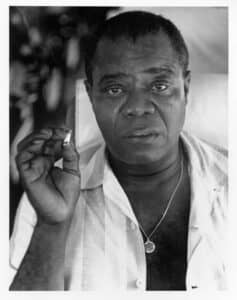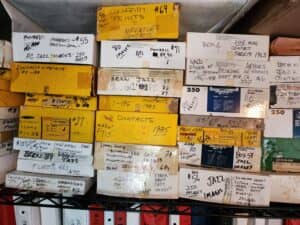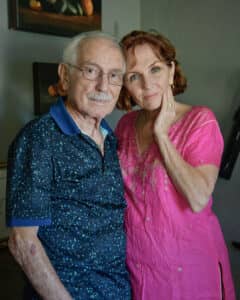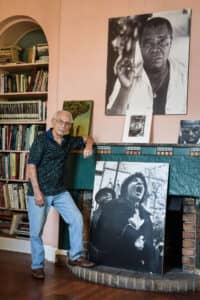Create
Frame job: What will become of Herb Snitzer’s archive?


“Pops on the Road,” 1960, by Herb Snitzer.
A famous portrait of a meditative Louis Armstrong used to hang over the fireplace in the home photographer Herb Snitzer shared with his wife, artist Carol Dameron. Snitzer had snapped the candid, Pops on the Road, in 1960.
In every room of the South St. Petersburg house, Cameron feels the presence of her late husband. Snitzer died Dec. 31 of complications from Parkinson’s Disease, complicated by dementia and exacerbated by Covid-19. He was 90.
The 3×4 foot Satchmo print is currently stashed in a closet.
“When he died, my kids took it down and put my self-portrait up,” Dameron says. “They were trying to help me. And it did, it helped me not to be so upset. I loved having it up in the house, but … I don’t know about tomorrow. For now, it seems that my children were right about it.”
Carol and Herb were a couple for 29 years, married for 21. She, the New Orleans-bred painter who studied at the Louvre Museum and the Centre Americain in Paris, among others places, during a 10-year European residency; he, the sharp-eyed Philadelphian who’d shot for Life Magazine and the New York Times and chronicled, like no other photographer, the great artists of the 1950s and ‘60s jazz movement in and around New York City.

Photo by Bill DeYoung.
Snitzer’s massive archive of more than two million black and white negatives and thousands of carefully-stored prints takes up an entire upstairs room. Through his website, Snitzer sold his work – an 11×14 silver gelatin print, matted and signed by the photographer, cost $1,000. The larger the custom art print, the higher the cost.
Collectors crave vintage prints, created within a decade of the original shoot (these sell for much more).
Such Sweet Thunder, a limited-edition, boxed portfolio of 10 silver gelatin jazz portraits, each numbered and signed by the photographer, sells for $22,000 and up. There are only a few such portfolios, assembled by Snitzer in 1995, left in the archive.

Herb Snitzer and Carol Dameron. Photo by Tom Kramer.
There are entire series of abstracts, collages, nudes, experimental “parallel” photo pairings, plus images of children, tugboats, horseshoe crabs, street scenes and architecture from Paris, London, New York and Philadelphia.
Book and periodical publishers pay big money for leasing rights to his work.
Snitzer was also known for his lifelong support of civil rights activism and public demonstrations. “There’s a whole closet full of big, framed political pieces,” Dameron says.
“He marketed the jazz because it fit, because these were famous names … but he was incredibly well-rounded. The jazz is not the whole thing.”
As she eases into the next phase of her life, Dameron is attempting to find a home for the archive – and the business. She’s had the collection appraised, and has been approached by the Smithsonian Institution and others about a possible purchase. Her husband’s life’s work, she believes, needs go where it will be best appreciated.
“Herb wanted his archive placed,” she says, “and he left it with me because he knew I’m the one to do it.”
The online store, for the moment, is at a standstill. “I’ve pretty much closed shop, because if someone orders a print, we can have a printer make it, but Herb’s got to sign it. And he’s not here to sign it. So I can’t, ethically, produce more work, because the signature has the value also. In the art world, that’s significant.”

Dameron and self-portrait. Photo by Tom Kramer.
In 1991, Carol Dameron was a single mom, living in St. Petersburg and making a good living selling her oil paintings. She was introduced to Herb Snitzer, a recent arrival from Cambridge, Massachusetts.
They had next-door studios on the second floor of the Salt Creek Artworks gallery.
He took her to a Rolling Stones concert at Tampa Stadium; his nephew, saxophonist Andy Snitzer, was one of the backing musicians.
Rubbing shoulders backstage with Mick and Keith, she recalls, “I felt that Herb was trying to impress me. And he did – that was a good date.”
They flew to Washington, D.C. to catch a Vermeer exhibit. In New York, they went to the Met for a production of Don Giovanni.
He never name-dropped, Dameron explains, although he very well could have. That was, simply, not Herb Snitzer’s style.

“Reflected Trane,” Herb Snitzer, 1961.
She remembers the first photo he showed her. Reflected ‘Trane depicted John Coltrane in 1961, reflected in a mirror backstage at The Village Gate in New York. “Hey, you’re great,” she remembers saying to him.
“I would not have gone out with an artist if I did not love his work. That wouldn’t work out.”
Dameron was familiar with classic jazz. Back home in New Orleans, her father was a gynecologist/obstetrician who also happened to be a talented jazz pianist. Dad relaxed at the end of a long workday by sitting down at the family’s Steinway and playing.
She showed her a photo he’d taken on assignment for Life, of the Duke and Duchess of Windsor on a cruise ship. “He just got how awful they were,” Dameron remembers. “Look what he got! He just knew, all day long.”
Once romance blossomed, there was no separating the newly-minted couple. “I ran my business, he ran his business,” Dameron says. “We were visual artists – he was a photographer, I was a painter, and those are different people. I never got up in his business – he was a grown man – and I had my own stuff to do.
“Something worked. And we worked together professionally. We just knew how to treat each other. We knew what to do, because we were both very focused and serious people. And so it worked.”
He was always direct, saying what he thought. She called him Mr. Brutal Reality, “because he would just say it.
“It was uncanny, he would just see things early, earlier than I would, earlier than others would, and he would just call it out. Or I’d meet someone, and Herb would say ‘Be careful.’ He just knew. Just as smart as he could be.”
Snitzer’s artistic sense, too, was finely honed. “I was working on the third part of a triptych, a commission piece, looking at this, this and this and stewing about it. Herb walked in, went to the image and put his hand over it, and just turned his hand. And the whole thing fell into place. It was amazing. And he wasn’t wrong.
“Sometimes, I’d say, you’re wrong, man. You’re not a painter! And I meant that. I didn’t agree with everything he said, but I would always consider it because it was coming from Herb Snitzer. He was just too smart and he had a great eye.”
They meshed with the St. Petersburg arts community, made friends and settled in.
And that’s how it went until Snitzer’s disease moved into their lives.
“Herb had lost the ability to say yay or nay to things. He was dissolving right in front of me. So I took over everything – took over the checkbook, answered the phone, made plans and leased images and sold work.”
She also fired several people who she suspected were taking advantage of her husband’s condition.
One day, perhaps the portrait of Louis Armstrong will go back on the living room wall.
Until then, Carol Dameron has memories that are all too fresh and vivid to contend with.
And, of course, there’s the archive. “I have my own career,” she says. “I had to forgo this because Herb got sick, and I took care of my husband. But now I want my life back.”

Photo by Tom Kramer.








Donna Kostreva
March 30, 2023at8:13 pm
Snitzer’s life’s work needs to be preserved in whole, for it is a national treasure documenting the very history of jazz, America’s art form. This collection is a gift to the entire world. Wishing you strength, vision and fortitude in accomplishing this!